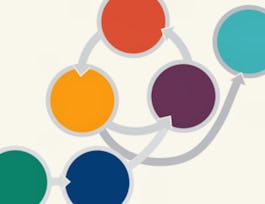While agile has become the de facto standard for managing digital innovation teams, many wonder if they’re doing it ‘right’. Twitter is full of jokes about how teams say they do agile but don’t ‘really’ do it. The reality is that getting the most out of agile is less about observing specific procedures and more about how a team focuses and measures their progress.


Managing an Agile Team
This course is part of multiple programs.
Taught in English
Some content may not be translated

Instructor: Alex Cowan
63,339 already enrolled
Course
(1,313 reviews)
94%
What you'll learn
How to select and test agile practices to adaptively improve your team’s practice of agile
How to create an agile team charter that aligns your team’s focus with company strategy while leaving it free to work creatively
How to facilitate retrospectives with your team to iteratively, collaboratively improve your practice of agile
How to support your team’s transition to agile
Details to know

Add to your LinkedIn profile
3 quizzes
Course
(1,313 reviews)
94%
See how employees at top companies are mastering in-demand skills

Build your subject-matter expertise
- Learn new concepts from industry experts
- Gain a foundational understanding of a subject or tool
- Develop job-relevant skills with hands-on projects
- Earn a shareable career certificate


Earn a career certificate
Add this credential to your LinkedIn profile, resume, or CV
Share it on social media and in your performance review

There are 4 modules in this course
This week we’ll introduce the four fundamental jobs of software development to help you define what’s important to your team and, hence, which of the many agile practices might make the most sense for you to try out. Then we’ll talk about achieving alignment with your company while maintaining autonomy through an agile team charter. We’ll close by stepping through the leading agile methodologies--Scrum, XP, and kanban. You’ll finish the week with an understanding of how to pair what’s important to your team with the best of what agile has to offer.
What's included
20 videos2 readings1 quiz1 discussion prompt
One of the most critical focal points for any team is facilitating a focus on outcomes over output. Without this, you’ll never graduate from responding to requests about your to-do list of output to driving better user outcomes that move the needle for your company. This week, you’ll learn how to define and prioritize what’s important to your team in the areas of learning and deciding, and to pair those with relevant agile practices from Scrum, XP, and kanban.
What's included
21 videos1 quiz1 discussion prompt
This week we’ll dive into the jobs of building software and the core management jobs in running an agile team. Agile--and XP in particular--offers a rich body of work on specific coding practices. We’ll step through a few of the most prominent and discuss key linkages with the other concepts and practices you’ve learned. On the job of managing, we’ll dive deeper into what that means and what works in an agile context.
What's included
23 videos1 quiz1 discussion prompt
Now that you’ve learned about the four jobs of software development, you’ll have a chance to think through how they relate to your work in this week’s peer-reviewed assignment. You’ll finish the course with a clear plan to accomplish the jobs of learning, deciding, building, and managing for your project.
What's included
6 videos1 peer review
Instructor

Offered by
Recommended if you're interested in Design and Product

University of Virginia

University of Virginia

University of Virginia

University of Virginia
Why people choose Coursera for their career




Learner reviews
Showing 3 of 1313
1,313 reviews
- 5 stars
77.41%
- 4 stars
17.94%
- 3 stars
3.04%
- 2 stars
0.76%
- 1 star
0.83%
New to Design and Product? Start here.

Open new doors with Coursera Plus
Unlimited access to 7,000+ world-class courses, hands-on projects, and job-ready certificate programs - all included in your subscription
Advance your career with an online degree
Earn a degree from world-class universities - 100% online
Join over 3,400 global companies that choose Coursera for Business
Upskill your employees to excel in the digital economy
Frequently asked questions
Access to lectures and assignments depends on your type of enrollment. If you take a course in audit mode, you will be able to see most course materials for free. To access graded assignments and to earn a Certificate, you will need to purchase the Certificate experience, during or after your audit. If you don't see the audit option:
The course may not offer an audit option. You can try a Free Trial instead, or apply for Financial Aid.
The course may offer 'Full Course, No Certificate' instead. This option lets you see all course materials, submit required assessments, and get a final grade. This also means that you will not be able to purchase a Certificate experience.
When you enroll in the course, you get access to all of the courses in the Specialization, and you earn a certificate when you complete the work. Your electronic Certificate will be added to your Accomplishments page - from there, you can print your Certificate or add it to your LinkedIn profile. If you only want to read and view the course content, you can audit the course for free.
If you subscribed, you get a 7-day free trial during which you can cancel at no penalty. After that, we don’t give refunds, but you can cancel your subscription at any time. See our full refund policy.

